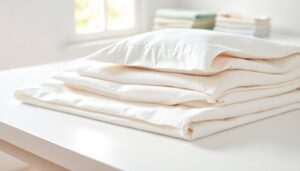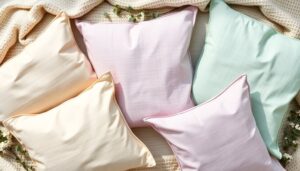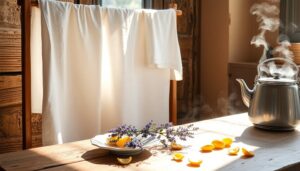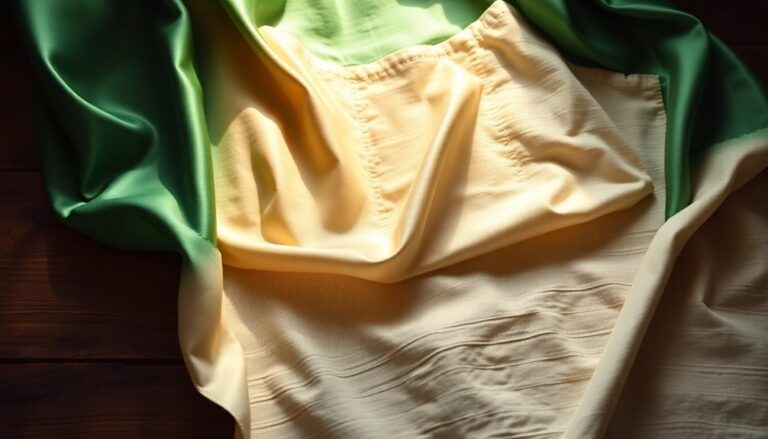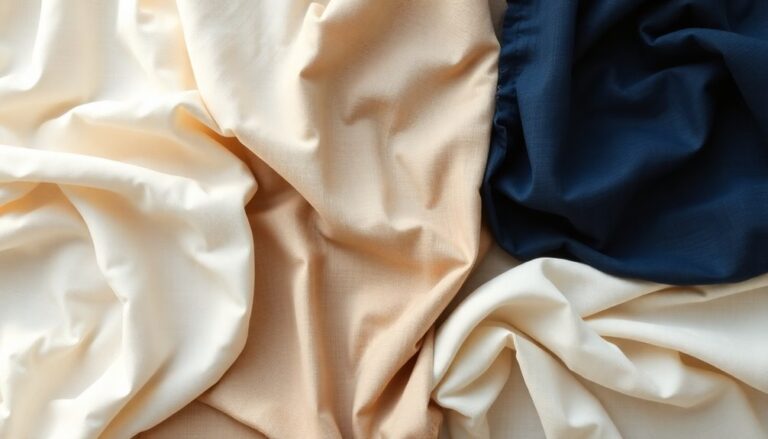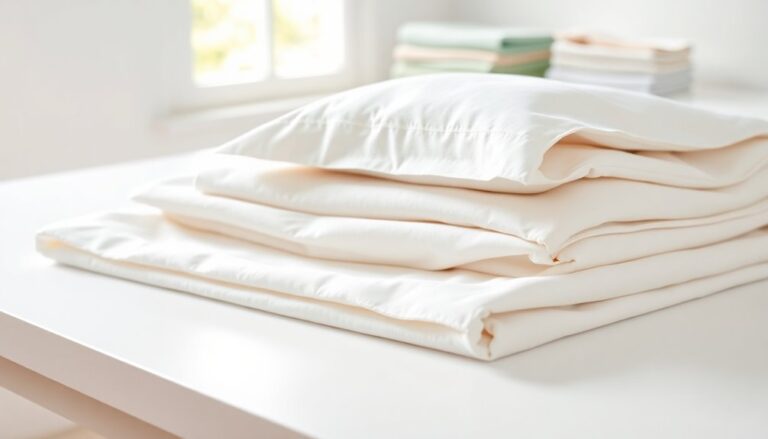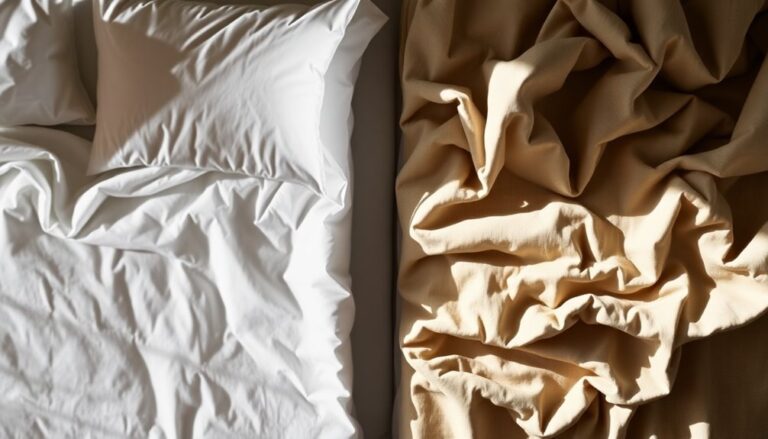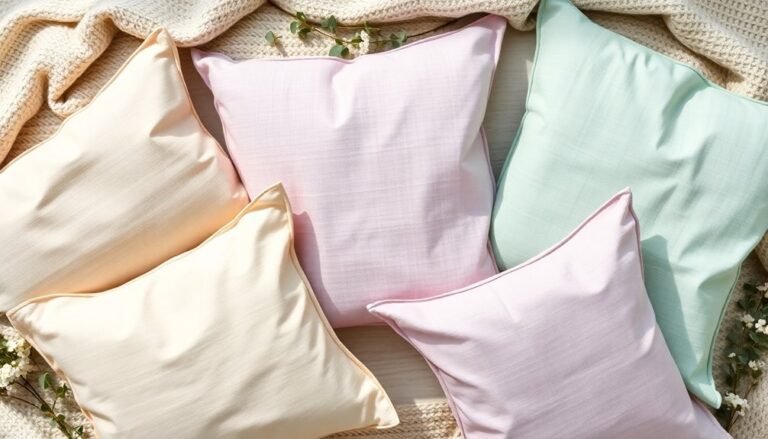Linen and muslin are distinct fabrics, each with unique characteristics. Linen, made from flax, is known for its durability, structured feel, and outstanding breathability. Muslin, crafted from cotton, offers a softer texture and is more affordable. As linen thrives in moisture-wicking and longevity, muslin shines in versatility for lighter applications. Both fabrics serve different purposes in fashion and home decor. Discovering their rich histories and varied uses can help in choosing the right fabric for specific projects.
Article Highlights
- Linen is made from flax fibers, while muslin is typically crafted from cotton fibers, making linen more durable.
- Linen has a textured feel, whereas muslin offers a smooth and soft touch against the skin.
- Linen excels in breathability and moisture-wicking, keeping wearers comfortable in warm conditions; muslin is less effective in moisture management.
- Linen is more durable and long-lasting, while muslin is softer but wears out faster over time.
- Care for linen involves machine washing on a gentle cycle, while muslin requires hand washing to maintain its quality.
History of Linen and Muslin
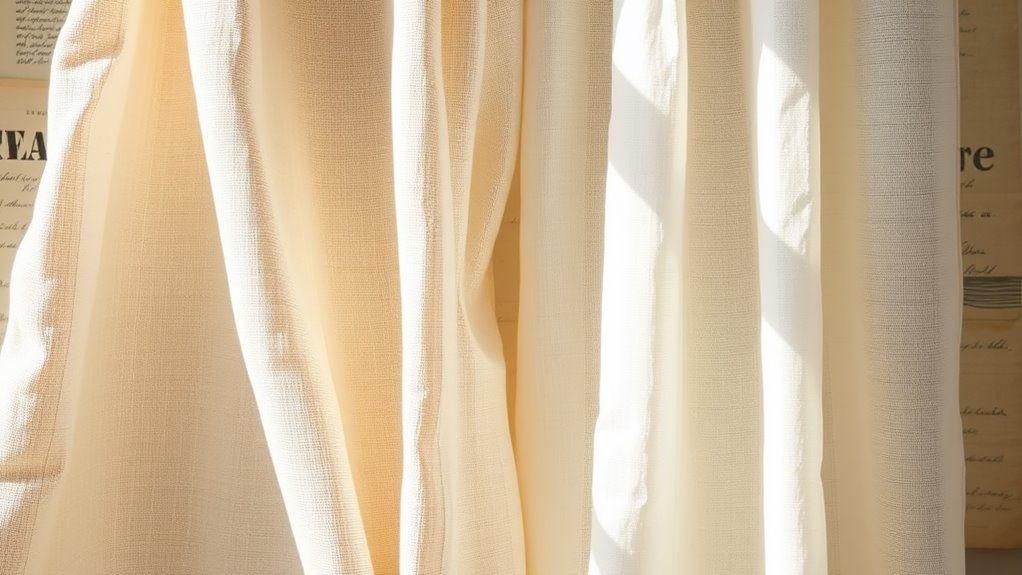
Although linen and muslin have distinct characteristics, their histories intertwine through centuries of textile development. Both fabrics boast ancient origins, with linen dating back to ancient Egypt, where it was prized for its durability and breathability. Muslin, in contrast, emerged in India, gaining fame during the Middle Ages for its lightweight and soft texture. The cultural significance of these textiles is profound; linen was often associated with wealth and purity, whereas muslin became a symbol of elegance and luxury in Europe. As trade routes expanded, both fabrics influenced fashion and social status, shaping the textile industry. Their evolution reflects not just practicality but also the artistry and tradition woven into human history.
Composition and Production
Although linen and muslin differ markedly in their composition and production methods, grasping these distinctions is essential for appreciating each fabric's unique qualities. Linen is primarily made from the fibers of the flax plant, which are harvested, processed, and woven into fabric. This process involves a labor-intensive method that highlights the natural characteristics of flax. Conversely, muslin is typically crafted from cotton fibers, which are more readily available and easier to process. The production methods for muslin often involve simpler weaving techniques, resulting in a lighter, more breathable fabric. Recognizing these fiber sources and their respective production methods sheds light on why linen tends to be more durable and luxurious, whereas muslin is prized for its affordability and versatility.
Texture and Feel
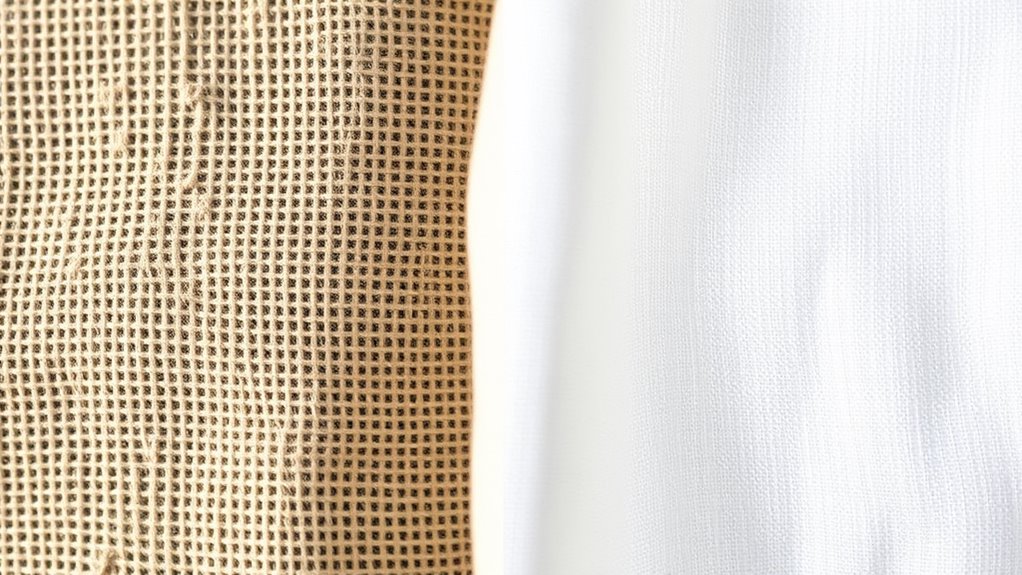
When comparing the texture and feel of linen and muslin, one can immediately notice significant differences that influence their applications. Linen boasts a natural firmness and crispness, whereas muslin is known for its soft, almost delicate touch. This softness comparison makes muslin ideal for lightweight garments and baby items, whereas linen’s sturdiness lends itself well to home decor and table linens. The difference between linen and muslin also extends to their durability and breathability. Linen, with its strong fibers, becomes softer with washing and is highly resistant to wear, making it a long-lasting choice for various applications. In contrast, muslin’s lighter weave allows for excellent airflow, making it a preferred fabric for warm-weather clothing and swaddling blankets.
Here are some key points to reflect upon:
- Linen provides a textured, slightly rough tactile experience.
- Muslin feels smooth and soft against the skin.
- The weight of linen offers a structured feel, whereas muslin drapes easily.
- Both fabrics age uniquely, enhancing their individual textures over time.
Understanding these differences can help in choosing the right fabric for specific projects.
Breathability and Moisture-Wicking Properties
Breathability and moisture-wicking properties are crucial elements to assess when choosing between linen and muslin, as each fabric offers distinct advantages. Linen is renowned for its outstanding breathability, allowing air to circulate freely, which helps regulate body temperature. Its moisture management capabilities likewise enable it to absorb and release moisture efficiently, keeping the wearer comfortable in warm conditions. Conversely, muslin, although breathable, may not wick moisture as effectively as linen. This fabric comparison reveals that linen typically thrives in environments where heat and humidity are concerns. In the end, those seeking peak breathability and moisture management might lean in the direction of linen, especially for summer wear, whereas muslin serves well for lighter applications and layering.
Durability and Care

Even though both linen and muslin have their merits, durability and care are key factors that can influence a buyer's decision. Linen is renowned for its impressive fabric longevity, often lasting for years with proper care. Conversely, muslin, although softer, is less durable and may wear out faster. When considering washing techniques, it is crucial to note that linen can withstand higher temperatures, making it easier to sanitize, whereas muslin requires more gentle handling to maintain its quality. Here are some tips for caring for each fabric:
- Linen: Machine wash on a gentle cycle, air dry to prevent shrinkage.
- Muslin: Hand wash or use a delicate cycle.
- Linen: Iron when damp for best results.
- Muslin: Avoid bleach to preserve softness.
Common Uses and Applications
The distinct properties of linen and muslin lend themselves to various applications across different industries. Linen, known for its strength and breathability, is often favored in the fashion industry, frequently seen in upscale garments and home textiles like tablecloths and curtains. Its luxurious feel aligns well with current fashion trends, making it a popular choice for summer collections. Conversely, muslin's lightweight and versatile nature makes it a staple in the textile industry, commonly used for making patterns and prototypes. It is likewise employed in culinary settings, as cheesecloth. Both fabrics serve unique purposes, reflecting their inherent qualities and the diverse needs of designers, manufacturers, and consumers alike.
Cost and Availability
When comparing linen and muslin, cost and availability play significant roles in their selection for various projects. Linen typically has a higher price point because of its labor-intensive production and quality, while muslin is usually more affordable and widely available. This difference in pricing trends can impact budget-conscious consumers.
Here are four key points regarding their cost and sourcing:
- Linen: Often sourced from specific regions, contributing to higher costs.
- Muslin: Sourced from a variety of manufacturers, making it more accessible.
- Pricing Trends: Linen prices can fluctuate based on demand and harvest conditions.
- Fabric Sourcing: Muslin's versatility allows for diverse sourcing options, enhancing its affordability.
Choosing the Right Fabric for Your Project
Taking into account the differences in cost and availability between linen and muslin, selecting the right fabric for a project involves evaluating specific needs and desired outcomes. For projects requiring durability and a luxurious finish, linen may be the better choice, regardless of its higher cost. Conversely, muslin's affordability and versatility make it ideal for practice pieces or garments needing less structure. When making fabric selection decisions, it's crucial to assess project requirements, such as the intended use, drape, and ease of care. Furthermore, those working on quilting or crafting may prioritize muslin for its lightweight qualities, whereas upholstery projects may benefit from linen's sturdiness. Ultimately, comprehending these factors helps guarantee the selected fabric aligns with the vision and functionality of the project.
Frequently Asked Questions
Can Linen and Muslin Be Used Interchangeably in Sewing Projects?
When considering if linen and muslin can be used interchangeably in sewing projects, one must look at their fabric characteristics. Linen's durability and breathability lend themselves well to structured garments, whereas muslin's lightweight and soft nature suits drapery and mock-ups. Though both fabrics can serve similar purposes, the choice of sewing techniques may differ because of their unique properties. It's crucial for a sewist to understand these nuances before making a decision.
Are There Any Eco-Friendly Options for Linen and Muslin?
When considering eco-friendly options for fabric, one can find sustainable sourcing for both linen and muslin. Many brands offer organic options, ensuring that the materials are grown without harmful chemicals. Linen, derived from flax, often requires less water, making it a more sustainable choice. Muslin can likewise be sourced organically, providing a versatile fabric that's kind to the environment. Overall, both fabrics can be found in eco-friendly varieties suitable for various projects.
How Do Color Options Differ Between Linen and Muslin?
In the realm of textiles, color options can paint a lively picture. Regarding linen and muslin, color availability varies considerably. Linen often boasts rich, earthy tones, achieved through natural dyeing techniques, giving it a timeless appeal. Muslin, conversely, is a blank canvas, readily accepting a wide range of dyes, allowing for more experimentation. So, during linen whispers subtle sophistication, muslin shouts versatility in color.
Which Fabric Is Better for Quilting: Linen or Muslin?
When considering which fabric's better for quilting, it's crucial to weigh fabric durability and quilting techniques. Muslin is often preferred because of its smooth texture and ability to hold intricate patterns, making it ideal for various quilting techniques. Linen, although durable and beautiful, can be less forgiving regarding fraying and stretching. In the end, quilters may find muslin easier to work with, especially for those intricate designs they love to create.
Can Linen and Muslin Shrink After Washing?
When fabric meets water, it can be a dance of change. Both linen and muslin possess unique shrinkage characteristics that come alive after washing. If not treated carefully, linen may shrink considerably because of its natural fibers, whereas muslin tends to maintain its shape better. Washing methods play an essential role; gentle cycles and cold water can help minimize shrinkage in both fabrics, ensuring they remain true to size and ready for use.

